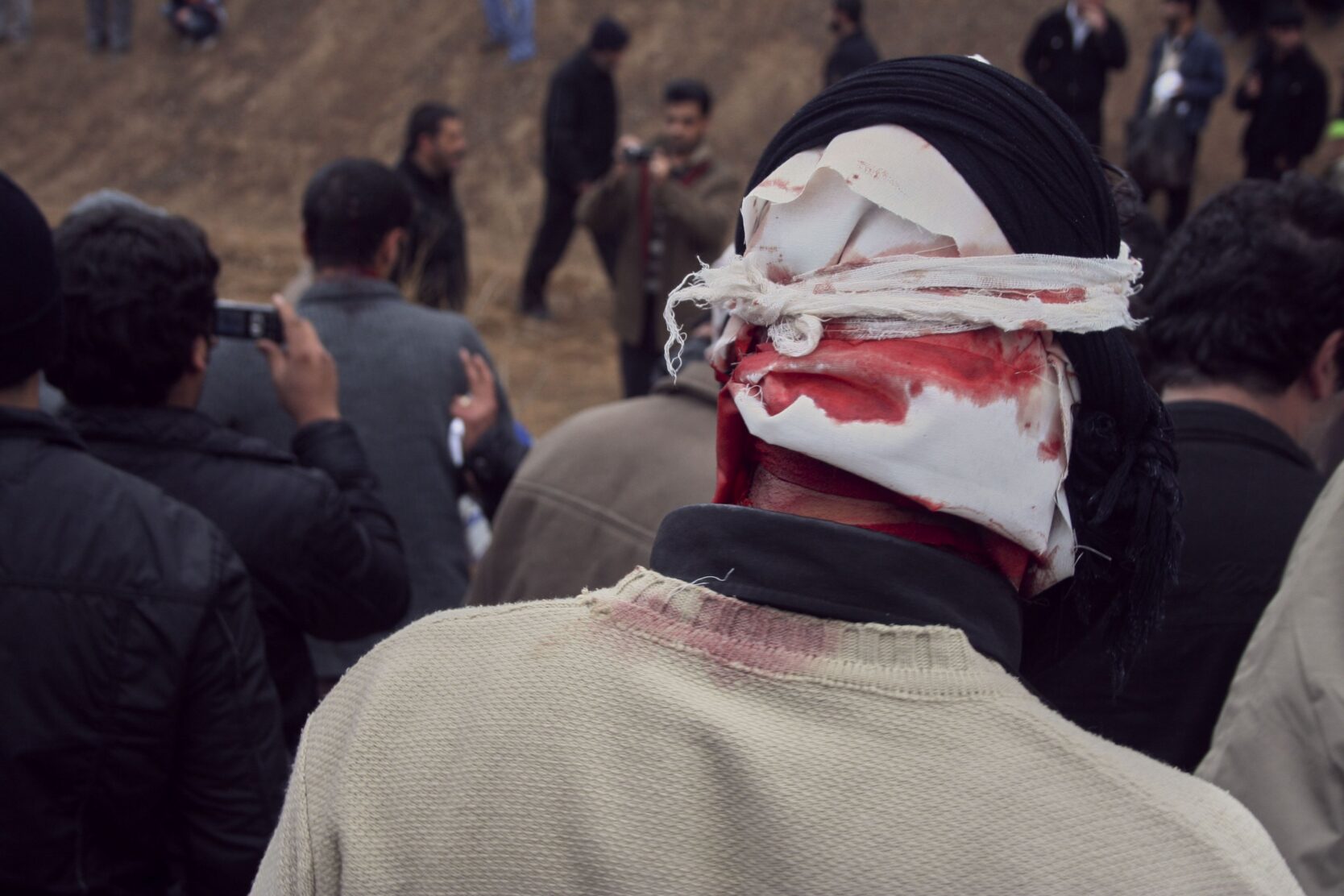Hot-rodding it straight at the guard booth of Iran’s most notorious prison after eating opium may have been unwise. The freaking shock of it, however, was a punchy counter to the constipation that Persian poppy sap brings – and life’s about balance, right?
Not that I shit myself anyway, but maybe the night-guard fronting Tehran’s Evin Prison did when our blue Peugeot roared off the street and gunned straight at his booth. The man rose slo-mo from his chair, jaw dropping, eyes widening to lock on mine.
My lunatic buddy at the wheel — an ex regime-paramilitary-turned-human whom I’ll call Arman –– then spun the car, rubber spraying as we screeched and smoked a 180, and floored it the fuck out.
“You’re fucking insane!” I yelled.
Arman rocketed us into a residential area, and then slowed way, way, down, laughing and laughing.
We were night-cruising during a previous major wave of unrest and crackdown to roil Iran — this was 2009, when millions took to the streets, hundreds were killed, and thousands arrested as the regime crushed widespread protests and dissent which lasted for several months. The unrest broke out after a disputed election, if it can be even called an election when the Supreme Leader and his unelected Supreme Council of 12 men hand-pick who can stand for office, then rig it even amongst the candidates they allow, intensify repression, and firewall the whole country.
So, in 2009, as now, the Islamic Republic’s torture chambers and gallows got busy. In just the first eight weeks of the post-election protests, 112 people were executed, according to Amnesty International — many strung up where Arman and I had just burned through a half donut.
“Divan-a,” I say, using the Persian for crazy.
He chuckles. “Now you’ve seen the Hotel Evin,” said Arman, using the nickname Iranians have for that caged little city of pain on Tehran’s northern fringes.
Opened in 1972, the Hotel Evin was built by the last Shah of Iran, Mohammed Reza Pahlavi, as dual — but rival — Communist and Islamist opposition to his U.S.-backed authoritarian rule gained momentum.
The hotel’s “guests” were often delivered to torture and execution by SAVAK, the national intelligence and security agency the U.S. helped set up after America, with British assistance, ran Operation Ajax, the 1953 coup d’état that rid Iran of its last democratically elected government (and, with it, that administration’s policy of nationalizing Iran’s oil industry).
Here’s something that might give American history buffs a chuckle: training the brutal SAVAK’s first generation of agents was New Jersey State Police superintendent turned U.S. Army Major General Herbert Norman Schwarzkopf – father of Herbert Norman Schwarzkopf Jr., a.k.a. Stormin’ Norman, the U.S. Army General who commanded U.S. and Coalition forces to victory in the 1991 Gulf War. Young Norman even lived in Tehran as a kid, pre-coup, while his dad did the kind of networking that soon proved so useful for ending democracy in Iran.
After the 1979 revolution, a complex, factionalized process in which the Islamist opposition ultimately triumphed and then attacked other movements, the Hotel Evin was expanded from a capacity of about 1,500 guests to 15,000, with atrocities and abuses likewise scaled up and mass hangings a frequent event on Iran’s calendar of submission.
It’s making headlines worldwide again, after footage emerged of recent gunfire and a major blaze at Evin, leaving several prisoners dead and dozens injured. This happened as the prison has been filling with people swept up in the Islamic State’s attempts to stamp out the wave of protests that have erupted since the death in custody of a 22-year-old woman arrested in Tehran for ‘bad-hijab’ — meaning immodestly presenting oneself.
Mahsa Amini had been grabbed off the street by a Guidance Patrol unit that accused her of insufficiently covering her hair. She was driven in a van to a police station where she collapsed. She fell into a coma and died two days later. The government says that Amini passed away due to underlying health conditions. Her family says it was from a beating in the van.
Much as Amini quickly became a global icon in Iran’s grim passion play, back in 2009 the regime’s killing in the streets of Tehran of another young woman made international news and supercharged anti-government fury. Neda Aghan-Soltan, 26, was walking amidst fellow protestors when she was shot by a member of the regime’s national goon squad, the Basij (of which Arman had been a member until he read Bertrand Russell during a temporary relaxation of Iran’s censorship, and quit).
Women in Iran are required to obscure the form of their bodies by wearing a chador, translating as ‘tent,’ or pants and a long formless coat for which they use the French-derived word, manteau. Women’s hair is to be covered by a scarf, known as a hijab — meaning a veil or barrier.
At a party I attended one snowy night in a high-rise apartment when I was there in 2009, all women arrived at the door duly obscured. Crossing the threshold, however, then went different ways for different women. Some maintained the manteau and hijab and spoke of how this was an expression of their faith. Their faith. Not the regime’s. And that such practices should never be forced.
Others, once that heavy door closed behind them, changed into red heels and gold boots, hung their mandated ‘modesty’ on hooks by the entrance, adjusted their designer tank-tops, adorned their decolletage with glittering bling, voofed their hair, and strode into the gathering.
The host was a pious man, and he asked that no one drink in his apartment. Immediately some thirty of us squeezed onto a balcony to pass around cups of wine that a friend of the host poured from a five-gallon tub. “Have you been to Shiraz?” he said. “This is where the first wine in the world was made, thousands of years ago. It is the Persian culture.”
On the afternoon before burning rubber at the prison, I criss-crossed Tehran with a woman I’ll call Anoush. Highly educated, multilingual, extensively travelled, Anoush bristled at the smothering rule-by-goons. On our day out she wore a reversible jacket: bright red on one side and dull black on the other. When security forces were in sight she had the drab side showing. When the coast was clear it was switcheroo time to sinful scarlet.
Yet, dress codes are just the tip of the iceberg in Iran, where women are subject to all manner of Jim Crow-style insults and limitations. When Anoush and I boarded a bus, hanging onto straps a third or so of the way along, she nudged me and said to look back at the rear section – where every other woman on the bus was jammed.
“Are you meant to be there, too?” I asked.
“Yes, but fuck that,” she said.
Anoush and I went our separate ways before I met Arman for a night-drive on opium. My various Iranian contacts did not want to know anything about each other, because arrests and torture were such a present threat that they didn’t want to have any names or other details that could be extracted.
Foreign journalists had been kicked out and such visas stopped. I went in under a tourist visa, stating that my reason for travel was to see traditional Persian wrestling. Stupid, I know, and after Arman – who still had contacts in military intelligence – talked me through the domestic surveillance system and warned that I’d probably be picked up and placed in a shipping container, I threw up.
Arman said to expect a tap on the shoulder at Tehran’s Imam Khomeini International Airport, right when I was about to board a flight the hell out of Iran. So I should carry nothing political or related to the unrest.
He also said my wife — safely outside Iran –- should change all my email and other passwords to anything I could not guess. This, Arman explained, was because it would do no one any good if the authorities got hold of my correspondence with Iranians and about this trip.
When I protested the idea I’d give up my passwords, Arman smiled. “Very quickly they will know what you know,” he said.
Love and respect for poetry runs deep in Iranian culture — my hotel in Tehran was the Hafez, named after a 14th century Persian poet — so in the final days I refashioned a month’s worth of notes into an epic (and epically bad) poem
I also, distressingly, said no to a trusted friend who had run risks for me. I did so when he asked if I would carry out a CD burned with cell phone footage. “Please show the world,” he said of chaotic, horrifying scenes of relentless shooting closing in on terrified young protesters at a train station entrance, of bloody bodies and groans and death-moans, of police plowing into crowds in SUVs and leaving trails of dead and injured, and more.
Arman would only meet at night: so late that Tehran, a choking, teeming, tense city of more than 8 million, was a quiet place of empty roads, its muted dots of light glimmering in all directions but north, where spread the vast starless void of the Alborz ranges.
Cruising in the small hours, occasionally seeing security forces keeping watch, a souped-up street racer flew by us. Across its back windshield stretched a decal of a sun-disk with wings extending far to either side.
“They’re Zoroastrians,” said Arman, grinning. “That’s the symbol of Ahura Mazda, their God. Iran’s god before Islam.”





